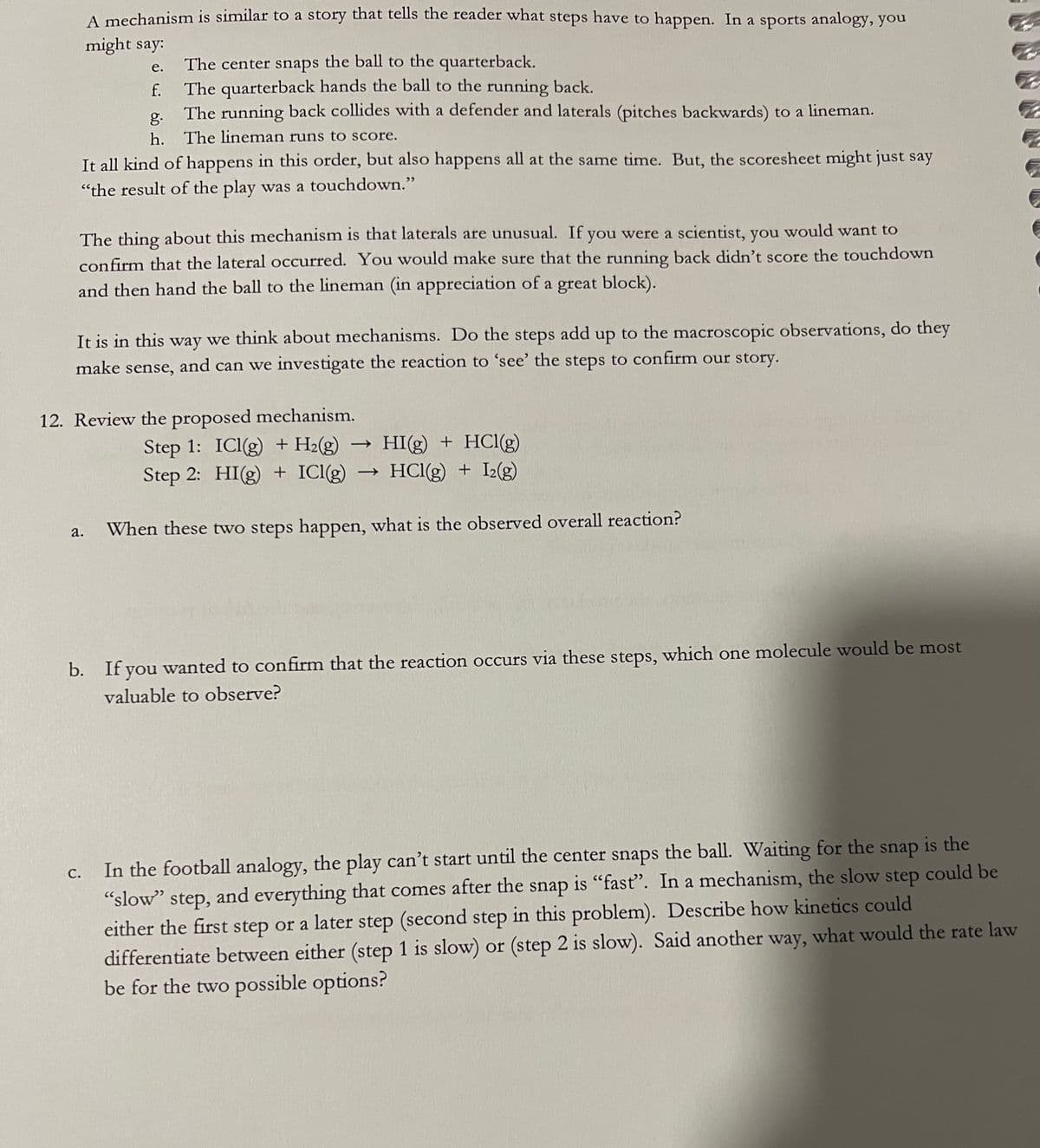Physical Chemistry
2nd Edition
ISBN:9781133958437
Author:Ball, David W. (david Warren), BAER, Tomas
Publisher:Ball, David W. (david Warren), BAER, Tomas
Chapter6: Equilibria In Single-component Systems
Section: Chapter Questions
Problem 6.1E
Related questions
Question

Transcribed Image Text:A mechanism is similar to a story that tells the reader what steps have to happen. In a sports analogy, you
might say:
The center snaps the ball to the quarterback.
The quarterback hands the ball to the running back.
The running back collides with a defender and laterals (pitches backwards) to a lineman.
е.
f.
8.
h. The lineman runs to score.
It all kind of happens in this order, but also happens all at the same time. But, the scoresheet might just say
"the result of the play was a touchdown."
The thing about this mechanism is that laterals are unusual. If you were a scientist, you would want to
confirm that the lateral occurred. You would make sure that the running back didn't score the touchdown
and then hand the ball to the lineman (in appreciation of a great block).
It is in this way we think about mechanisms. Do the steps add up to the macroscopic observations, do they
make sense, and can we investigate the reaction to 'see' the steps to confirm our story.
12. Review the proposed mechanism.
Step 1: ICI(g) + H2(g)
Step 2: HI(g) + ICI(g) → HCI(g) + I2(g)
HI(g) + HCl(g)
|
When these two steps happen, what is the observed overall reaction?
а.
b. If you wanted to confirm that the reaction occurs via these steps, which one molecule would be most
valuable to observe?
In the football analogy, the play can't start until the center snaps the ball. Waiting for the snap is the
"slow" step, and everything that comes after the snap is "fast". In a mechanism, the slow step could be
either the first step or a later step (second step in this problem). Describe how kinetics could
differentiate between either (step 1 is slow) or (step 2 is slow). Said another way, what would the rate law
be for the two possible options?
С.
Expert Solution
This question has been solved!
Explore an expertly crafted, step-by-step solution for a thorough understanding of key concepts.
This is a popular solution!
Trending now
This is a popular solution!
Step by step
Solved in 3 steps with 2 images

Knowledge Booster
Learn more about
Need a deep-dive on the concept behind this application? Look no further. Learn more about this topic, chemistry and related others by exploring similar questions and additional content below.Recommended textbooks for you

Physical Chemistry
Chemistry
ISBN:
9781133958437
Author:
Ball, David W. (david Warren), BAER, Tomas
Publisher:
Wadsworth Cengage Learning,


Chemistry: Principles and Reactions
Chemistry
ISBN:
9781305079373
Author:
William L. Masterton, Cecile N. Hurley
Publisher:
Cengage Learning

Physical Chemistry
Chemistry
ISBN:
9781133958437
Author:
Ball, David W. (david Warren), BAER, Tomas
Publisher:
Wadsworth Cengage Learning,


Chemistry: Principles and Reactions
Chemistry
ISBN:
9781305079373
Author:
William L. Masterton, Cecile N. Hurley
Publisher:
Cengage Learning

Introductory Chemistry: A Foundation
Chemistry
ISBN:
9781337399425
Author:
Steven S. Zumdahl, Donald J. DeCoste
Publisher:
Cengage Learning